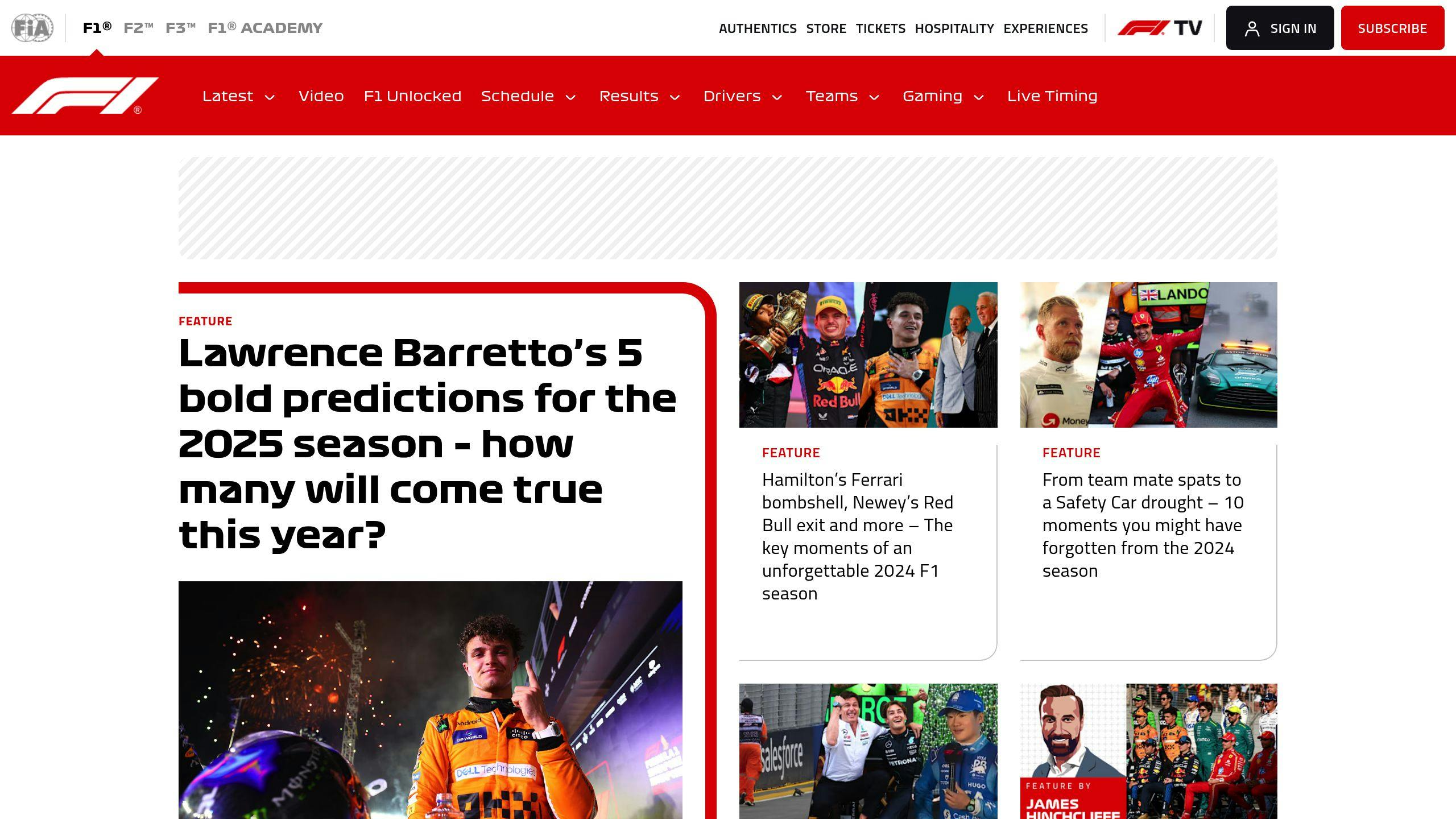
F1 Logos: Evolution Over Decades
The Formula 1 logo has evolved significantly since 1950, reflecting changes in design trends, technology, and branding needs. Here's a quick overview of its journey:
- 1950-1985: Simple, monochromatic design focused on functionality and visibility.
- 1987-1993: Introduced a bold yellow underline and a race car silhouette in the FIA lettering, adding dynamism.
- 1993-2018: Featured the iconic slanted "F" with negative space forming the "1", symbolizing speed and precision.
- 2018-Present: A modern, minimalist red design optimized for digital platforms, emphasizing simplicity and motion.
Each logo reflects the era's priorities, balancing tradition and modernity while adapting to the sport's growing global presence and technological advancements.
1. 1950-1985 F1 Logo
The first Formula 1 logo, introduced by the FIA in 1950, reflected the design priorities of the post-war era. It featured straightforward, functional elements with clean lines and minimal decoration, ensuring it was easy to recognize in both print and broadcast formats of the time.
Color Choices
Due to the printing technology of the mid-20th century, the logo primarily used monochromatic colors. This choice ensured it was clearly visible on race cars, in broadcasts, and on official documents.
Design Influences of the Time
The logo was heavily influenced by the post-war modernist movement, which emphasized simplicity and practicality. Its focus on clean lines and readability perfectly aligned with the design trends of the era.
Branding Approach
By maintaining a consistent design for 35 years, the logo helped establish Formula 1's identity as a premier motorsport. This commitment to simplicity and uniformity laid the foundation for the sport's global recognition and paved the way for the more dynamic designs introduced in the late 1980s as Formula 1's audience and technology advanced.
2. 1987-1993 F1 Logo
The 1987-1993 Formula 1 logo brought a fresh, dynamic look to the sport, building on the simplicity of the earlier design.
Design Elements
This logo introduced a compact black wordmark with a bold yellow underline, creating a clean yet striking appearance. Above the wordmark, the FIA lettering was prominently displayed. A standout feature was the clever use of negative space within the 'F' and 'A' of the FIA lettering, where a race car silhouette was subtly embedded - an ingenious nod to the sport's essence [1][3].
Color Schemes
The black and yellow color palette was bold and energetic, making the logo instantly recognizable across various platforms. The contrast also added a sense of authority and vibrancy [1][3].
Era-Specific Influences
The design reflected the late 1980s' preference for compact and visually impactful elements. During this time, Formula 1 was expanding its global reach, and the logo needed to resonate with an international audience while staying true to its professional roots. The hidden race car element demonstrated the era's push for creativity and efficiency in design [1][3].
Branding Strategy
This logo marked a shift towards a more assertive brand identity. Featuring the FIA lettering prominently emphasized Formula 1's connection to the governing body while reinforcing its individuality. Its compact design made it highly versatile, whether on TV screens or race car liveries, aligning with the sport's growing global appeal [1][3].
This design set the stage for the next evolution of Formula 1's branding, paving the way for even more dynamic changes in the years to come.
3. 1993-2018 F1 Logo
Design Elements
The 1993-2018 Formula 1 logo introduced a bold new look for the sport. Its standout feature was the angled "F" paired with dynamic speed lines, while the number "1" was cleverly revealed through the negative space next to it [1][3]. This smart design combined letters and numbers to perfectly capture the essence of speed and precision that defines Formula 1.
Color Schemes
The logo used a striking combination of black, red, and white. These colors represented energy, determination, and contrast, delivering a powerful and timeless visual. The palette worked effectively across various platforms, reinforcing Formula 1's identity wherever it appeared [1][3].
Era-Specific Influences
This design mirrored Formula 1's growing global presence and advancements in technology. Its clean and dynamic style matched the sport's shift from primarily European circuits to an expanding international audience across multiple continents [5].
Branding Strategy
Over its 25-year run, this logo became a globally recognized symbol of Formula 1. Its adaptability and ability to balance tradition with modernity made it a lasting emblem of the sport’s growth. It was prominently featured on official merchandise and became a key part of Formula 1's worldwide branding efforts [1][3].
In 2018, the logo was retired as Formula 1 embraced a new direction under fresh leadership, marking the end of an era for this iconic design.
sbb-itb-ab39e76
4. 2018-Present F1 Logo
Design Elements and Color Scheme
The 2018 F1 logo combines a sleek red 'F' with a diagonal '1,' creating a design that emphasizes speed and simplicity [1][3]. The bold red color ensures the logo stands out across various mediums, whether digital or physical, while staying aligned with current branding practices [2][4].
Era-Specific Influences
This design draws from modern trends like geometric shapes, clean lines, and dynamic layouts. These choices reflect Formula 1's shift toward a more digital presence, capturing the evolving nature of motorsport branding in a globalized, tech-driven world [3][4].
Branding Strategy
The redesign marked a key step in Liberty Media's efforts to modernize Formula 1's image and attract a broader audience [3]. As only the fourth major logo update in F1's long history, it initially faced pushback from some long-time fans [5]. Despite this, the logo has become a central piece of F1's strategy to prioritize digital engagement and expand its global reach.
While the redesign highlights Formula 1's forward-thinking approach, it also underscores the challenges that come with reimagining a legacy brand.
Advantages and Disadvantages
Over the years, each F1 logo design has brought its own strengths and weaknesses in representing the sport's brand. These changes reflect shifts in design trends and the growing need to adapt to digital platforms.
| Era | Key Advantages | Key Disadvantages |
|---|---|---|
| 1950-1985 | • Strong brand recognition • Simple and functional design • Easy to read across formats |
• Lacked visual appeal • Basic typography • Absence of dynamic elements |
| 1987-1993 | • Improved visual structure • Added dynamic yellow underline • Professional FIA integration |
• Short-lived usage • Limited memorability • Restrained color choices |
| 1993-2018 | • Clever use of negative space • Strong representation of speed • Memorable branding |
• Scaling issues for different sizes • Limited color options • Outdated design features |
| 2018-Present | • Optimized for digital use • Clean, modern aesthetic • Flexible for various applications |
• Less recognizable elements • Reduced connection to brand heritage |
This table shows how Formula 1's logos have evolved to meet changing demands and how each design tackles the challenge of balancing tradition with modernity.
The current design, introduced in 2018, focuses on clarity and ease of use across digital platforms. However, it has moved away from some of the sport's traditional elements [4]. Designers have had to juggle competing needs: creating a visually striking logo, ensuring it scales well, and maintaining brand identity in a rapidly changing media environment [3].
Initially, fans were hesitant about the 2018 design, but opinions have shifted over time. As Formula 1 grows its global presence, the logo has gained wider acceptance [5]. Communities like Formula Fanatics have embraced the sport's visual history, blending elements from past logos into merchandise, showing how F1's legacy continues to shape its modern image.
Conclusion
The evolution of Formula 1 logos over the past seventy years tells the story of the sport’s growth and transformation. From the simple designs of the 1950s to today’s modern emblem, each logo reflects the changing times and Formula 1’s rise as a global powerhouse.
The 1993-2018 logo, with its smart use of negative space to form the number "1" and dynamic speed marks, captured the sport's rapid expansion into markets across Asia and the Americas [3]. In contrast, the 2018 redesign took a bold step into the digital era, offering a streamlined look tailored for online platforms and modern media [4].
These designs are more than just aesthetic updates - they reveal how F1 has evolved while staying true to its roots. This visual journey not only reinforces F1's identity but also sets an example for other motorsport organizations navigating the digital age [2].
The impact of these logos goes beyond Formula 1 itself. Platforms like Formula Fanatics have drawn inspiration from past F1 designs, incorporating them into merchandise that blends the sport’s history with modern trends. This connection between tradition and innovation keeps the brand fresh while honoring its legacy.
As Formula 1 continues to grow and change, its logos will remain a powerful symbol of its journey. The evolution of these designs shows how balancing progress with heritage can create a lasting and impactful brand identity. F1’s logo history is a reflection of its rise from humble beginnings to a global phenomenon.
FAQs
Here are answers to some common questions about Formula 1's visual identity and team logos.
What year did the F1 logo change?
The F1 logo underwent a major redesign in 1987, featuring a bold yellow underline and a more compact look. In 1994, the sport introduced its well-known slanted 'F' logo, with speed marks forming the '1.' This design remained in place until Liberty Media's rebranding in 2017 [1].
What is the history of the McLaren logo?

McLaren's logo debuted in 1964 and featured a Kiwi bird, a nod to Bruce McLaren's New Zealand heritage. Created by motorsport artist Michael Turner, the design reflects an era when cultural elements were often incorporated into team branding [4].
When did the Formula 1 logo change?

The most recent update came in 2018 when Wieden+Kennedy introduced the current logo. This design features a forward-leaning, bright red "F" paired with a clean diagonal line forming the "1." It was only the fourth logo change in Formula 1's long history, emphasizing the sport's traditionally cautious approach to rebranding [3].
"The 2018 logo reflects modern minimalist design trends" [1].
These logo updates and branding shifts show how Formula 1 carefully blends its rich history with a forward-thinking approach to stay visually relevant.

